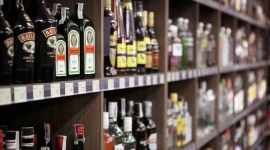Alcohol taxes may not be the answer to drunk-driving deaths
How the synthetic control method works
One of the main issues with studying policy changes is that in some cases, it’s nearly impossible to evaluate what would have happened if a certain policy were not enacted.
The synthetic control method allows researchers to model that kind of alternative reality. They can compare the outcomes of two version of a state: the actual state where the policy change occurred and the synthetic version created to estimate the oucome if the policy had not been enacted. Creating this synthetic state involves a weighted combination of other states that have similar histories and characteristics.
Through this method, researchers can test the effectiveness or ineffectiveness of policy changes.
The number of Americans killed in drunk-driving crashes has declined in recent decades, but that’s no comfort to the loved ones of the more than 10,000 people killed in such accidents each year. In fact, alcohol-related crashes still account for almost one-third of all US traffic fatalities.
This persistent problem has led state policymakers and advocacy groups to aggressively pursue solutions to reduce drunk driving, including raising excise taxes on alcohol. But do excise taxes have any effect drunk driving fatalities? The evidence is mixed.
Although excise taxes on other goods, such as cigarettes, have been shown to have a clear effect on people’s behavior (as well as provide additional revenue for the state), the effect of alcohol excise taxes on behavior is less conclusive. Some studies have found a steep drop in alcohol-related traffic deaths after increased excise taxes, but others have found no significant change after the tax hike.
To explore this issue, Robert McClelland and John Iselin of the Urban-Brookings Tax Policy Center studied two large increases of alcohol excise taxes in Illinois and found no evidence that they led to a long-term decline in the number of fatal alcohol-related motor vehicle crashes.
“There are good reasons for states to raise alcohol taxes, but preventing drunk-driving deaths probably isn't one of them,” McClelland said.
A state examination and creation
The federal government has played a major role in alcohol regulation, particularly with its moves in the 1980s that pressured states to raise the legal drinking age to 21 and establish limits on drivers’ blood alcohol content levels.
But states play an even larger role because the 21st amendment gives them broad latitude in how they regulate the sale and use of alcohol. Some of these efforts, which include instituting strict license-revocation or -suspension laws and establishing sobriety checkpoints, have effectively reduced drunk-driving deaths.
Faced with continual budget shortfalls, Illinois lawmakers used that latitude to pass two major increases in alcohol excise taxes over the past few decades: one in 1999 and another in 2009. The first increase more than doubled the tax rates for all beer, wine, and spirits. The second increase gave Illinois the 2nd-highest tax rate in the US for spirits, the 9th-highest for wine, and the 22nd-highest for beer.
These dramatic tax increases in Illinois provided an ideal opportunity to study the effects of alcohol excise taxes. McClelland and Iselin used the synthetic control method to create a hypothetical version of Illinois in which the tax increases never happened.
They found that the trends in fatal drunk driving crashes in the real Illinois and the hypothetical Illinois were closely aligned. The absence of a long-term deviation following the 1999 or 2009 tax increase indicates the policy was ineffective. In other words: There is no evidence that increasing alcohol excise taxes reduces drunk-driving deaths in the long term.
McClelland and Iselin found another interesting layer to the issue: People living in border counties might be traveling out of state to purchase alcohol and avoid the higher taxes.
In Illinois as a whole in 2008, about 31 percent of fatal crashes involved alcohol. That share declined slightly (by 3 percentage points) in 2011 following the tax hike, but it quickly rebounded back to 31 percent in 2012.
However, Illinois counties that don’t border other states saw a much steeper (8 percentage-point) decline in alcohol-related crashes in 2010. Similar to the state, that downward trend returned to previous levels in the following years: By 2013, the share of fatal crashes that involved alcohol had returned to its early 2000s level of around 30 percent.
Although the researchers didn’t study whether people were traveling out of state for their alcohol purchases, they inferred the trend, which aligns with the results of other studies looking at people’s behavior when facing higher excise taxes.
So why did that drop within interior counties last only a few years? McClelland noted two possible reasons: People might have gotten used to the higher prices, and some heavy drinkers might have opted for cheaper alcohol options rather than drinking less.
McClelland and Iselin were surprised to find no evidence of a long-term change in Illinois’s fatal alcohol-related crashes, especially because another study saw a significant drop-off after the state’s 2009 tax increase. Looking ahead, they said ongoing tracking of data from Illinois and improved use of the synthetic control method would be useful for further research.
The big picture
Reducing drunk driving is a constant battle. Despite the overall downward trend of drunk-driving crashes, there is still a long way to go before alcohol isn’t a factor in automotive accidents and fatalities.
Potential ways to reduce drunk driving deserve further study, but increasing alcohol excise taxes isn’t a definitive solution.
“People might not react to taxes the way you think they will,” Iselin said. “You need to anticipate all the ways they could respond, for example crossing state borders, if you’re trying to design policies that actually change behavior.”



